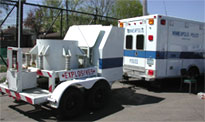Patrolman
John F. Young was killed by a bullet from the gun of a bandit early on
the morning of July 13, 1919, when he and Patrolman O.W. Hidinger saw
an automobile standing in the middle of the street near Second and
Washington Avenues North with the engine running. Walking
over to the side of the machine, Patrolman Young laid his hand on the
door, looked at the lone occupant and asked, “What are you doing here?” No sooner had he spoken than the man in the machine
placed an automatic pistol to Young’s breast and pulled the trigger.
Patrolman Young fell into the arms of Patrolman Hidinger who was
standing behind him. Before Hidinger could place Young
on the pavement and draw his own pistol, four men, attracted by the
shot, ran from a nearby alley entrance, jumped into the machine, and
started it toward Marquette Avenue. In the meantime,
Hidinger had put Patrolman Young down and taken out his pistol. He
fired a fusillade of shots at the fleeing machine, which was answered
by dozens of shots from the pistols of the men in the escaping
automobile. One of the bandit’s bullets struck Young as
he lay dying in the street. The automobile, when it cross Marquette
Avenue traveling on Washington Avenue South, was going at the rate of
about 60 miles an hour, Patrolman Hidinger said. Four
of his bullets, Hidinger said, struck the rear of the machine as it
fled down Washington Avenue, and another passed through the windshield.
This last bullet, he believed, wounded one of the bandits. Hidinger
said he saw one of the men hanging from the machine as though he had
been hurt. Four hours after the shooting, the car was
found abandoned in a sand pit opposite 1087 Minnehaha Street in St.
Paul. Its body, top and windshield showing evidence of the rain of
shots. Patrolman Young was taken to the city hospital, where he died 20 minutes later from the effect of his two wounds. Police
investigation later divulged that the four men who entered the car
after the first shot had been attempting to enter the office of the
Minneapolis Packing Company, although they had not succeeded in
jimmying the door. It is believed the “lookout” dropped his companions
at the entrance to the alley at Third Avenue North, driving around to
Second Avenue to wait for them. The packing company safe contained
considerable money, police said. A robbery of the place five years ago
netted $1,000.00. “Patrolman Young never had a chance,”
Chief of Police J.F. Walker declared. “He had no reason to expect
trouble, and in the darkness there was no opportunity to do more than
he did. He died as a brave man should, in the performance of his duty.” Patrolman Hidinger declared positively that he could
identify the man who shot Patrolman Young. Hidinger was close behind
Young as the latter approached the automobile from which the shots were
fired, and although the automobile was in a dark part of the street,
Hidinger saw the driver’s face distinctly in the reflection of the
headlights, he said. Hidinger described the driver as a heavyset man
with a large head but small features. The shooting
death of Patrolman Young by bandits and the holdup of the Windsor Hotel
in St. Paul by four men a day later led Minneapolis and St. Paul police
to believe the hotel bandits and the murders of Patrolman were the
same. “Every effort of the police departments of the Twin Cities are
being bent today in an effort to trap the murders,” declared Chief
Walker. “St. Paul police have cooperated with us in every way possible.
Although they guarded every avenue of escape, the men may have gotten
away through St. Anthony Park.” St. Paul police chief
John J. O’Connor advanced the theory that the murder of Patrolman Young
was committed by Chicago gangsmen. A recent clean up of Chicago had
driven many men and women of unsavory reputation to other cities, and
it was thought possible that the five men came to the Twin Cities
together from Chicago. In spite of a reward of $500.00
for information leading to the arrest and conviction of the murderer
that was offered by Mayor J.E. Meyers, and the arrest of numerous
suspects by both city policy departments, no one was identified or
charged with Patrolman Young’s murder. Funds were
collected for the benefit of the families of Patrolman Young and
Patrolman George F. Woessner, a motorcycle policeman killed in an
accident approximately three weeks earlier on June 24th, and deposited
at the Midland National Bank. Patrolman Young was 50
years old and a 26-year veteran of the police department. He lived at
2517 Twenty-eighth Avenue South with his wife and children. Funeral
services for Young took place at his residence, followed by services at
Holy Rosary Church. Interment was at St. Mary’s cemetery on July 16,
1919. Chief of Police Walker headed a delegation of Minneapolis
policeman and detectives who marched in the funeral procession. The
pallbearers were all men with whom Young had worked. More than 1,000 persons attended the services, it was estimated. | 
